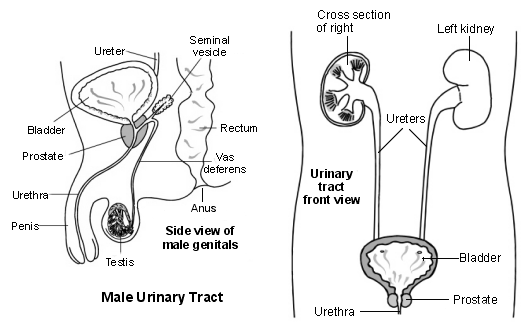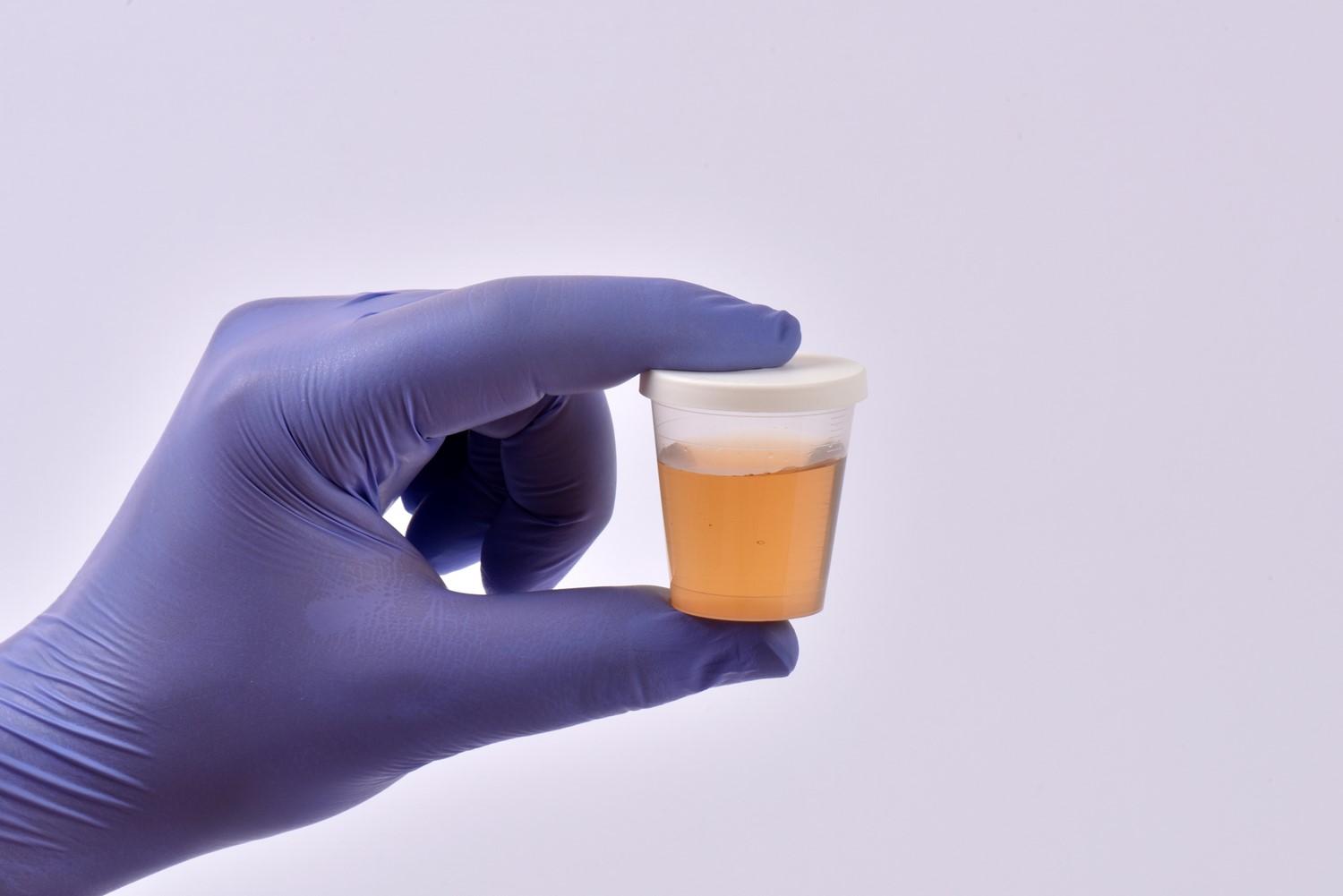Urine infection in men
Peer reviewed by Dr Philippa Vincent, MRCGPLast updated by Dr Rosalyn Adleman, MRCGPLast updated 15 Sept 2024
Meets Patient’s editorial guidelines
- DownloadDownload
- Share
- Language
- Discussion
Most urine infections in men are caused by germs (bacteria) which come from your own bowel. They cause no harm in your bowel but can cause infection if they get into other parts of your body. Some bacteria lie around your back passage (anus) after you pass a stool (faeces).
These bacteria sometimes travel to the tube which passes urine from your bladder (the urethra) to the outside. Some bacteria thrive in urine and multiply quickly to cause infection.
A urine infection is often called a urinary tract infection (UTI) by doctors. When the infection is just in the bladder and urethra, this is called a lower UTI, or cystitis. If it travels up to affect one or both kidneys as well then it is called an upper UTI or pyelonephritis. This can be more serious than lower UTIs, as the kidneys can become damaged by the infection.
In this article:
Male genitals side view and urinary tract cross-section diagram

Continue reading below
How common are urine infections in men?
UTIs are rare in men aged under 50. They become more common in older men. Urine infection is much more common in women.
What causes a urine infection in men?
In some cases an underlying problem can increase the risk of developing a UTI in men. These include the following:
Bladder problems. For example conditions that make it difficult to completely empty the bladder.
Kidney problems. For example, kidney stones.
Having a urinary catheter.
In other cases the UTI occurs for no apparent reason.
Continue reading below
Symptoms of a urine infection in men
Symptoms of a UTI in men will depend on where the infection occurs.
Infection in the bladder (cystitis) symptoms:
Pain on emptying the bladder
Passing urine more frequently.
Passing small amounts of urine.
Pain in the lower tummy (abdomen).
Urine may become cloudy, bloody or smelly.
Infection in the kidneys symptoms:
Pain in a loin (the side of the lower back over the kidney).
A high temperature (fever).
Feeling or being sick (vomiting).
Feeling generally unwell.
In some elderly men, the only symptoms may be a recent onset of confusion or just feeling generally unwell or unsteady, even without any actual urinary symptoms.
Diagnosing a urine infection in men
A urine test can confirm the diagnosis and identify the germ (bacterium) causing the infection. Further tests are not usually necessary if otherwise well with a one-off infection. However, a doctor may advise tests of the kidney, prostate gland or bladder if an underlying problem is suspected.
An underlying problem is more likely if the infection does not clear with an antibiotic medicine, or if there are:
Symptoms that suggest a kidney is infected (not just the bladder).
Recurring urine infections, for example, two in a six-month period.
Problems with the kidney in the past, such as kidney stones or a damaged kidney.
Symptoms that suggest an obstruction to the flow of urine.
Blood-stained urine which persists after treatment with antibiotics.
UTI tests may include:
An examination of the prostate gland by examination of the back passage (rectum).
Blood tests which may include kidney function tests and a specific blood test to check on the prostate, called prostate specific antigen, or PSA.
A scan of the kidneys or bladder such as an ultrasound scan.
An X-ray or CT scan to look for kidney stones.
A look inside the bladder with a special camera (cystoscopy).
Tests to see how well the bladder is working, called urodynamic tests.
Continue reading below
What is the treatment for a urine infection in men?
A short course of antibiotics will usually clear the infection quickly. This is usually for seven days in men. Medical advice should be sought if the symptoms are not gone, or nearly gone, after the course of antibiotics is completed, or if the symptoms are getting worse whilst on the treatment.
Paracetamol will usually ease any pain, discomfort, or high temperature (fever).
Have plenty to drink to help prevent a lack of fluid in the body (dehydration).
Preventing a urine infection in men
The following can help prevent urine infections in men:
Drinking enough fluids to avoid dehydration.
Emptying the bladder when needed and not "holding on".
Passing urine soon after sexual intercourse.
Sometimes preventive antibiotics are recommended to prevent recurrent UTIs. These are usually given daily at a low dose for several months. The antibiotics are often rotated to prevent antibiotic resistance from occurring. The antibiotics used include: nitrofurantoin, trimethoprim, cefalexin and amoxicillin.
What is the outlook (prognosis)?
The vast majority of men improve within a few days of starting treatment. If symptoms do not improve despite taking an antibiotic medicine, then an alternative antibiotic might be needed. This is because some germs (bacteria) are resistant to some types of antibiotics. This can be identified from tests done on the urine sample.
Occasionally the infection may spread and cause you more significant symptoms. Infection in the bladder (cystitis) may spread to the kidney (pyelonephritis).
Infection may also spread to involve the prostate gland, causing infection of the prostate gland (prostatitis).
Recurring urine infection in men
Recurrent urine infections are defined as two or more infections in six months or three or more infections in a year. It is unusual for men to have recurring urine infections.
Men with recurring infections may be referred to a urology specialist for further tests to try and establish why they are occurring.
Blood tests to assess the kidney and prostate gland, and ultrasound scans to look at the kidneys, bladder and prostate gland, will often be organised before seeing the urology specialists.
Patient picks for Urinary problems in men

Kidney and urinary tract
Urinary retention
Urinary retention means that you are having problems emptying the bladder completely. It may occur suddenly (acute urinary retention) or it may develop over a longer period of time (chronic urinary retention). Acute urinary retention is a medical emergency. Urinary retention is more common in men than in women. It becomes more common as you become older. In men aged in their 70s, urinary retention occurs in about 1 in every 100 men. For men in their 80s, urinary retention occurs in about 3 in every 100 men. You may need tests to help find the cause of your urinary retention. The treatment and outcome for both acute and chronic urinary retention will depend on the underlying cause. You should see a doctor immediately if you are unable to pass any urine when your bladder feels full and painful.
by Dr Rosalyn Adleman, MRCGP

Men's health
Lower urinary tract symptoms in men
Lower urinary tract symptoms (LUTS) are a very common problem, especially in men over the age of 65 years. They can be caused by various conditions. These symptoms may include slowing of the urine stream and needing to get up to pass urine at night. There are different causes of LUTS and the treatment will depend on the cause. Some men choose not to have treatment if their symptoms are not too bothersome and the cause is not serious.
by Dr Philippa Vincent, MRCGP
Further reading and references
- Urinary tract infection (lower): antimicrobial prescribing; NICE Guidance (October 2018)
- Smithson A, Ramos J, Nino E, et al; Characteristics of febrile urinary tract infections in older male adults. BMC Geriatr. 2019 Nov 29;19(1):334. doi: 10.1186/s12877-019-1360-3.
- Urological infections; European Association of Urology (2022 -updated 2024)
- Urinary tract infection (lower) - men; NICE CKS, December 2024 (UK access only)
Continue reading below
Article history
The information on this page is written and peer reviewed by qualified clinicians.
Next review due: 14 Sept 2027
15 Sept 2024 | Latest version

Ask, share, connect.
Browse discussions, ask questions, and share experiences across hundreds of health topics.

Feeling unwell?
Assess your symptoms online for free
Sign up to the Patient newsletter
Your weekly dose of clear, trustworthy health advice - written to help you feel informed, confident and in control.
By subscribing you accept our Privacy Policy. You can unsubscribe at any time. We never sell your data.